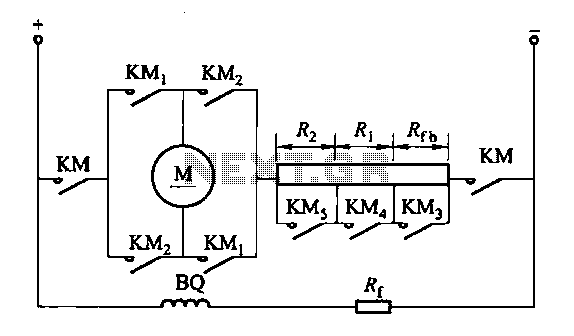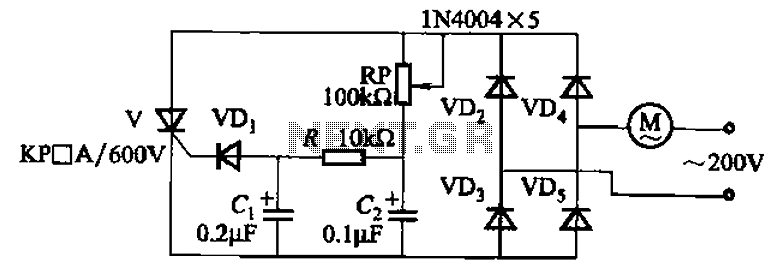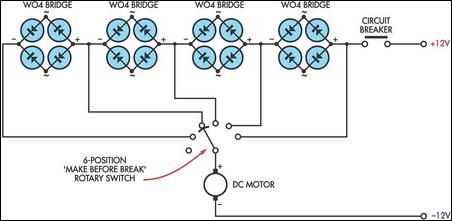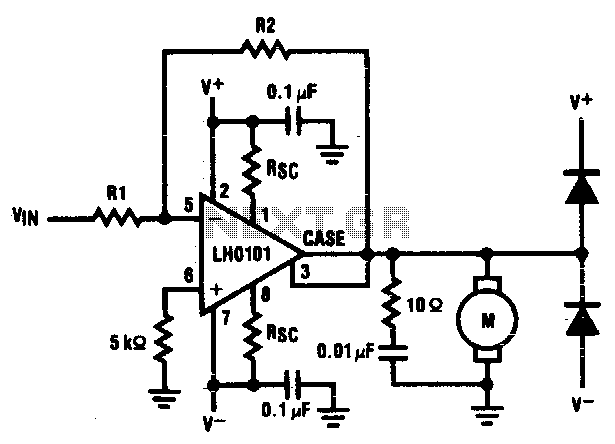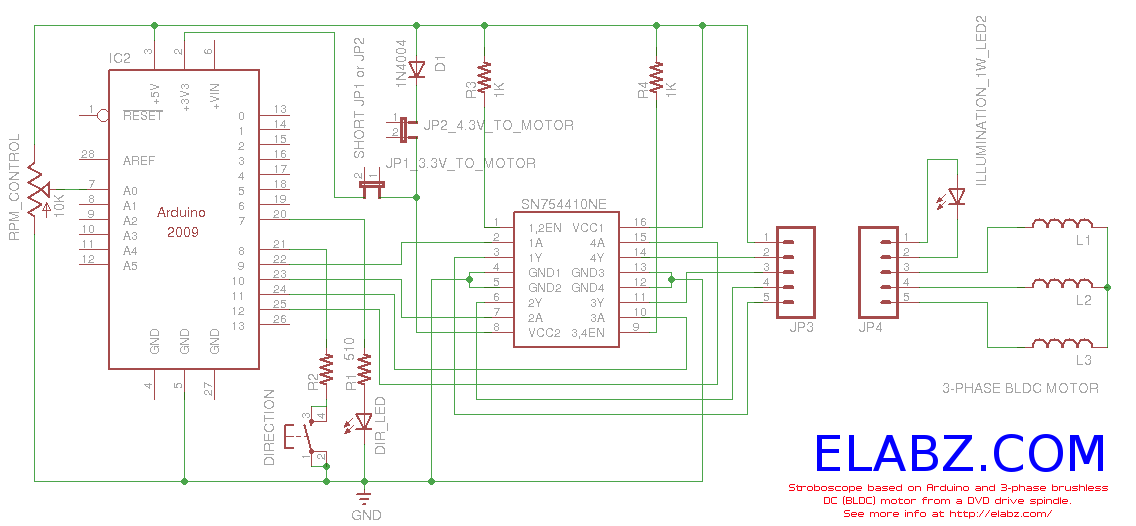
Unipolar Stepper Motor Controllers
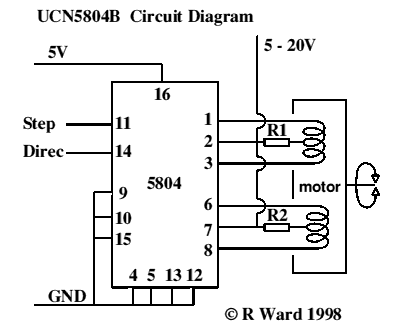
This integrated circuit is highly efficient and does not require any external glue logic for operation. It features two pins to control a motor: one for direction and the other for stepping pulse triggers. The design is compact and supports 5, 6, or 8 wire stepper motors. The 5 and 8 wire motors are variations of the 6 wire motor, where the 5 wire motor has its two common wires from the coils' center taps connected internally, reducing external connections. However, there can be some confusion regarding the coil connections, which may require trial and error for proper pairing without causing damage. For 8 wire motors, the center taps need to be identified independently, and experimentation may be necessary to determine the correct polarity. Resistors R1 and R2 are recommended when the supply voltage exceeds approximately 10 volts, primarily for tuning motor response times at high speeds. Data sheets provide additional details. Six wire motors are widely available and offer clear connections, making them suitable for applications requiring significant power, such as printers. Non-functional dot matrix printers are common sources for these motors, which can also provide belts, pulleys, gears, and possibly a power supply for experimental use.
The integrated circuit described is designed to efficiently drive stepper motors with minimal external components, making it ideal for compact applications. The two control pins facilitate straightforward operation by allowing users to manage both the direction of the motor and the timing of the stepping pulses. This simplicity is particularly advantageous in scenarios where space and complexity must be minimized.
When dealing with 5 or 8 wire stepper motors, it is essential to recognize their configurations. The 5 wire motor's internal connection of the center taps streamlines the wiring process, but users must be cautious during setup to ensure the correct connections of the remaining coil ends. This may involve some experimentation, as the identification of coil pairs can lead to confusion. The 8 wire motors, while more flexible due to their additional wires, require careful mapping of the center taps and an understanding of coil polarities, which may necessitate testing to achieve optimal performance.
The inclusion of resistors R1 and R2 becomes critical when operating at higher voltages, as they help manage the current and voltage levels to the motor, ensuring reliable operation and protecting the circuit from potential damage. These resistors are particularly useful in high-speed applications, where the response time of the motor is crucial for maintaining performance.
In practical applications, six wire stepper motors are preferred due to their widespread availability and ease of connection. These motors are commonly used in various devices, including printers, where their power capabilities are essential. For those seeking to experiment with stepper motors, non-working dot matrix printers serve as an excellent resource, providing not only motors but also additional mechanical components like belts and gears that can be repurposed for various projects. This approach not only promotes hands-on learning but also encourages innovation in motor control applications.This is a very good integrated circuit. There is no need for any external glue logic to drive the circuit, there is only 2 pins to drive the motor, one for controlling the direction and the other to trigger the stepping pulses. It provides a very compact design that drives 5 or 6 or 8 wire stepper motors. The 5 or 8 wire stepper motors are treated as a variation on the 6 wire motor. That is, the 5 has the two common wires from the coils center taps joined inside the motor (saves joining them outside the motor), however some confusion may occur with the ends of the other coils as to which joins with which, however trial and error to determine this will not hurt anything. In the 8 wire motor case the joined center taps will have to worked out by you. You will know which coil is joined to which coil, however experimentation may be required to determine polarity.
The resistors R1 & R2 are only necessary if the supply voltage to the motors is above 10 volts or so, and are really only necessary near max voltages and tuning the response times of the motor for high speeds. See data sheets for details. There should be very little problem getting hold of six wire motors that make the connections obvious.
These motors are by far the most common where any degree of power is required, e. g. in printers. Non-working dot matrix printers are fairly common now-a-days and the motors in them are excellent starting points for experimentation. You will also get belts, pulleys and gears thrown in (may be even a power supply if your are adventurous).
🔗 External reference
The integrated circuit described is designed to efficiently drive stepper motors with minimal external components, making it ideal for compact applications. The two control pins facilitate straightforward operation by allowing users to manage both the direction of the motor and the timing of the stepping pulses. This simplicity is particularly advantageous in scenarios where space and complexity must be minimized.
When dealing with 5 or 8 wire stepper motors, it is essential to recognize their configurations. The 5 wire motor's internal connection of the center taps streamlines the wiring process, but users must be cautious during setup to ensure the correct connections of the remaining coil ends. This may involve some experimentation, as the identification of coil pairs can lead to confusion. The 8 wire motors, while more flexible due to their additional wires, require careful mapping of the center taps and an understanding of coil polarities, which may necessitate testing to achieve optimal performance.
The inclusion of resistors R1 and R2 becomes critical when operating at higher voltages, as they help manage the current and voltage levels to the motor, ensuring reliable operation and protecting the circuit from potential damage. These resistors are particularly useful in high-speed applications, where the response time of the motor is crucial for maintaining performance.
In practical applications, six wire stepper motors are preferred due to their widespread availability and ease of connection. These motors are commonly used in various devices, including printers, where their power capabilities are essential. For those seeking to experiment with stepper motors, non-working dot matrix printers serve as an excellent resource, providing not only motors but also additional mechanical components like belts and gears that can be repurposed for various projects. This approach not only promotes hands-on learning but also encourages innovation in motor control applications.This is a very good integrated circuit. There is no need for any external glue logic to drive the circuit, there is only 2 pins to drive the motor, one for controlling the direction and the other to trigger the stepping pulses. It provides a very compact design that drives 5 or 6 or 8 wire stepper motors. The 5 or 8 wire stepper motors are treated as a variation on the 6 wire motor. That is, the 5 has the two common wires from the coils center taps joined inside the motor (saves joining them outside the motor), however some confusion may occur with the ends of the other coils as to which joins with which, however trial and error to determine this will not hurt anything. In the 8 wire motor case the joined center taps will have to worked out by you. You will know which coil is joined to which coil, however experimentation may be required to determine polarity.
The resistors R1 & R2 are only necessary if the supply voltage to the motors is above 10 volts or so, and are really only necessary near max voltages and tuning the response times of the motor for high speeds. See data sheets for details. There should be very little problem getting hold of six wire motors that make the connections obvious.
These motors are by far the most common where any degree of power is required, e. g. in printers. Non-working dot matrix printers are fairly common now-a-days and the motors in them are excellent starting points for experimentation. You will also get belts, pulleys and gears thrown in (may be even a power supply if your are adventurous).
🔗 External reference
